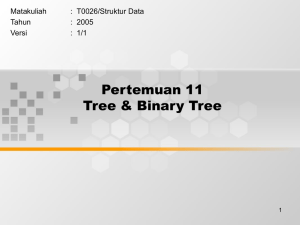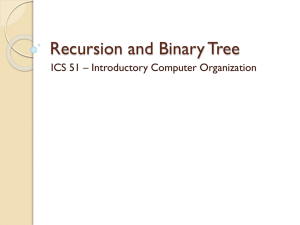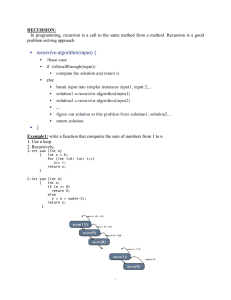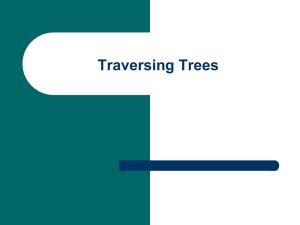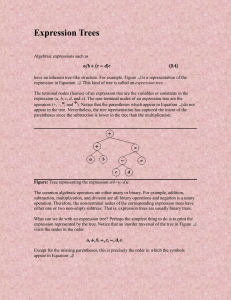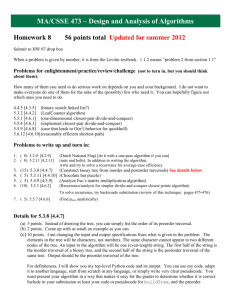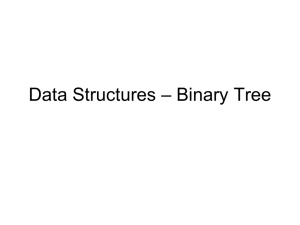Trees lecture - NYU Computer Science Department
advertisement
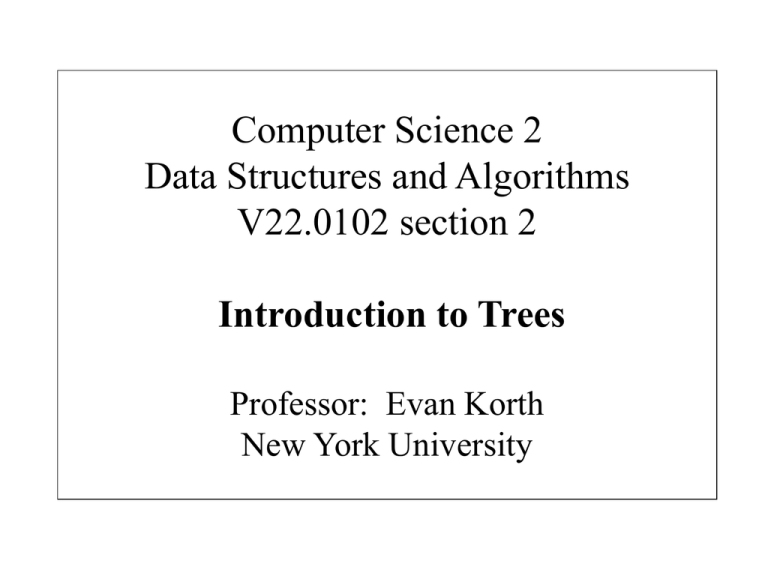
Computer Science 2
Data Structures and Algorithms
V22.0102 section 2
Introduction to Trees
Professor: Evan Korth
New York University
Road Map
• Introduction to trees
– Terminology
• Binary trees
• Tree traversal
• Reading: 4.1 – 4.2
Tree
• Tree defined recursively
• A tree is a collection of nodes. The collection can
be empty; otherwise, a tree consists of a
distinguished node r, called the root, and zero or
more non-empty (sub) trees T1, T2, …, Tk each of
whose roots are connected by a directed edge from
r.
• A tree is a collection of N nodes, one of which is
the root and N-1 edges.
Source:Mark Allen Weiss
Tree terminology
• The root of each subtree is said to be a child
of r and r is said to be the parent of each
subtree root.
• Leaves: nodes with no children (also known
as external nodes)
• Internal Nodes: nodes with children
• Siblings: nodes with the same parent
Source:Mark Allen Weiss - edited by Evan Korth
Tree terminology (continued)
• A path from node n1 to nk is defined as a sequence
of nodes n1, n2, …, nk such that ni is the parent of
ni+1 for 1<= i <= k.
• The length of this path is the number of edges on
the path namely k-1.
• The length of the path from a node to itself is 0.
• There is exactly one path from the root to each
node.
Source:Mark Allen Weiss
Tree terminology (continued)
• Depth (of node): the length of the unique
path from the root to a node.
• Depth (of tree): The depth of a tree is equal
to the depth of its deepest leaf.
• Height (of node): the length of the longest
path from a node to a leaf.
– All leaves have a height of 0
– The height of the root is equal to the depth of
the tree
Source:Mark Allen Weiss
Tree Example
• In class: On blackboard
Binary trees
• A binary tree is a tree in which no node can
have more than two children.
• Each node has an element, a reference to a
left child and a reference to a right child.
Picture of a binary tree
a
b
d
g
Source: David Matuszek
c
e
h
f
i
l
j
k
Tree traversals
• A binary tree is defined recursively: it consists of a
root, a left subtree, and a right subtree
• To traverse (or walk) the binary tree is to visit each
node in the binary tree exactly once
• Tree traversals are naturally recursive
• Since a binary tree has three “parts,” there are six
possible ways to traverse the binary tree:
– root, right, left
– root, left, right
– right, root, left
– left, root, right
– right, left, root
– left, right, root
Source: David Matuszek
Preorder traversal
• In preorder, the root is visited first
• Here’s a preorder traversal to print out all
the elements in the binary tree:
public void preorderPrint(BinaryTree bt)
{
1 if (bt == null) return;
2 System.out.println(bt.value);
3 preorderPrint(bt.leftChild);
4 preorderPrint(bt.rightChild);
}
Source: David Matuszek
Inorder traversal
• In inorder, the root is visited in the middle
• Here’s an inorder traversal to print out all
the elements in the binary tree:
public void inorderPrint(BinaryTree bt)
{
if (bt == null) return;
inorderPrint(bt.leftChild);
System.out.println(bt.value);
inorderPrint(bt.rightChild);
}
Source: David Matuszek
Postorder traversal
• In postorder, the root is visited last
• Here’s a postorder traversal to print out all
the elements in the binary tree:
public void postorderPrint(BinaryTree
bt) {
if (bt == null) return;
postorderPrint(bt.leftChild);
postorderPrint(bt.rightChild);
System.out.println(bt.value);
}
Source: David Matuszek
Tree traversals using “flags”
• The order in which the nodes are visited during a tree
traversal can be easily determined by imagining there
is a “flag” attached to each node, as follows:
preorder
inorder
postorder
• To traverse the tree, collect the flags:
A
B
D
C
E
F
ABDECFG
Source: David Matuszek
A
A
B
G
D
B
C
E
F
DBEAFCG
G
D
C
E
F
DEBFGCA
G
Other traversals
• The other traversals are the reverse of these
three standard ones
– That is, the right subtree is traversed before the left
subtree is traversed
• Reverse preorder: root, right subtree, left subtree
• Reverse inorder: right subtree, root, left subtree
• Reverse postorder: right subtree, left subtree,
root
Source: David Matuszek
Arithmetic Expression Tree
• Binary tree for an arithmetic expression
– internal nodes: operators
– leaves: operands
• Example: arithmetic expression tree for the expression
((2 (5 - 1)) + (3 2))
+
-
2
5
3
1
2
Print Arithmetic Expressions
• inorder traversal:
– print “(“ before traversing
left subtree
– print operand or operator
when visiting node
– print “)“ after traversing right
subtree
+
-
2
5
3
1
2
void printTree(t)
//binary operands only
if (t.left != null)
print("(");
printTree (t.left);
print(t.element );
if (t.right != null)
printTree (t.right);
print (")");
((2 (5 - 1)) + (3 2))
Evaluate Arithmetic Expressions
• postorder traversal
int evaluate (t)
//binary operators only
if (t.left == null)
//external node
return t.element;
else //internal node
x = evaluate (t.left);
y = evaluate (t.right);
let o be the operator
t.element
z = apply o to x and y
return z;
– Recursively evaluate
subtrees
– Apply the operator
after subtrees are
evaluated
+
-
2
5
3
1
2

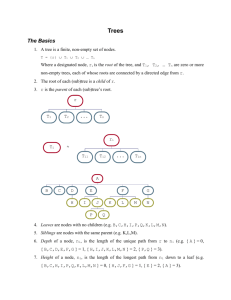
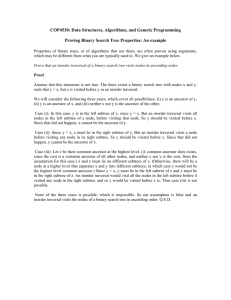
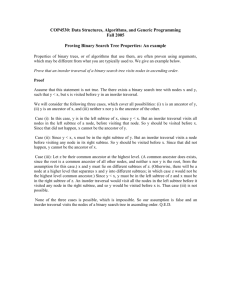
![Question#4 [25 points]](http://s3.studylib.net/store/data/007289590_1-57e227b5dac30eb17dd4115b9416253c-300x300.png)
